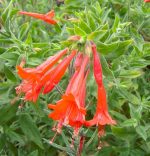
California fuchsia, also known as hummingbird flower and firechalice, is a semi evergreen subshrub and a member of the evening primrose family, Onagraceae, that also includes Gaura and Clarkia. It is native to dry slopes, scrub, and lightly shaded stream edges from California to Baja where different populations show considerable variations in appearance and habit. Plants grow 24″ -36″ tall from dense suckering crown and have upright to sprawling stems with lance-shaped to narrowly oval foliage covered with soft or woolly hair. Terminal racemes of tubular red to pink to scarlet flowers appear from mid summer into fall. Each flower has 4 notched petals, protruding stamens, and a 4 lobed petal-like sheath around the tube, creating the appearance of 8 petals. They are very attractive to hummingbirds. Plants spread by rhizomes and from large dense matting or mounding colonies up to 3′ wide. Cultivars are available that vary most significantly in size, color of flowers and foliage, habit, drought tolerance, and suckering. California fuchsia is a good choice for butterfly gardens,rock gardens and xeriscapes. The genus name, Zauschneria, honors Johann Baptista Josef Zauscher, a 18th century professor of medicine and botany in Prague. The specific epithet, californica, refers to the area where the plant is native. The alternate genus name, Epilobium, comes from the Greek words epi meaning upon and lobos meaning lobe or pod and refers to the fact that the flower and capsule appear together, with the corolla borne on the end of the ovary. The alternate specific epithet, canum, comes from the Latin word canum meaning gray hairs and refers to the hairs on the leaves.
Type: Semi-evergreen subshrub
Bloom: Terminal racemes of pink to scarlet tubular flowers from mid summer to fall
Size: 2-3′ H x 3′ W
Light: Full sun to partial shade
Soil: Average, dry to medium moist, well-drained
Hardiness: Zones 8-10
Care: Cut to the ground after flowering to promote bushiness.
Pests and Diseases: Susceptible to leaf hopper, tomato hornworms, root mealy bug
Propagation: Seed, cuttings, division in fall or winter
Companion Plants: Deer grass, Salvia spp., goldenbush, Aster chilensis, and milkweeds
Outstanding Selections:
‘John Bixby’ (dense, round form, smaller than species)
‘Bowman’ (gray-green foliage, upright, orange-red flowers)
‘Catalina’ (large plant, white gray cast to foliage)
‘Ed Carman’ (large flowers and leaves)
Note: Needs protection from wind